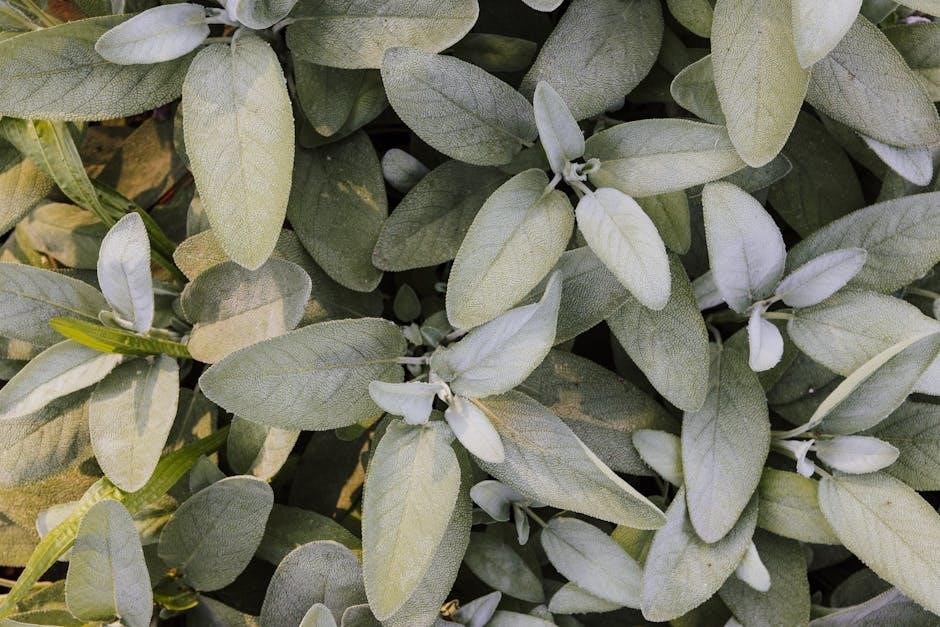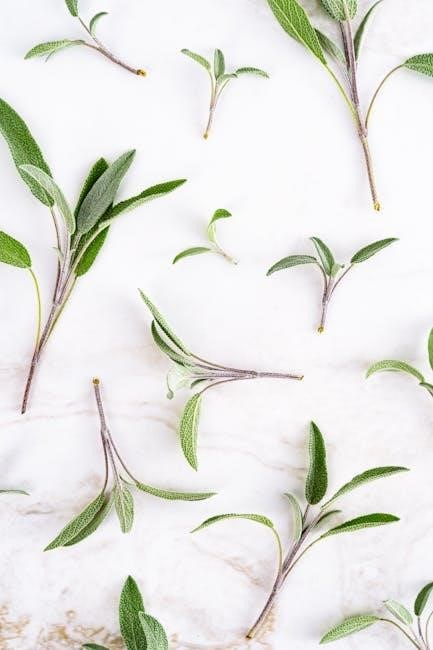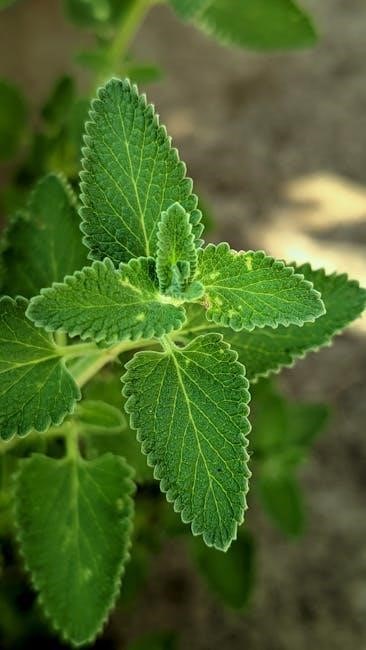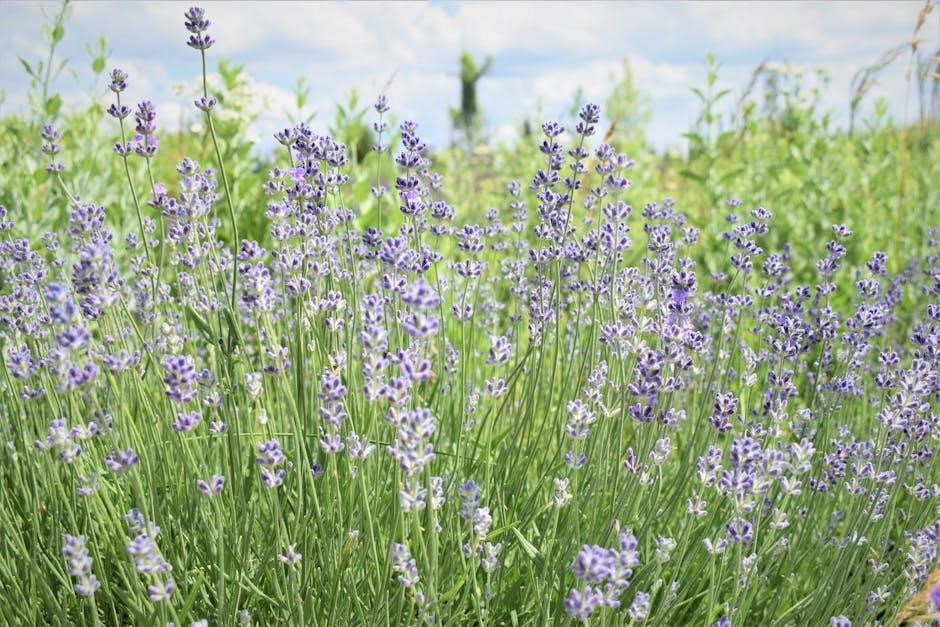This comprehensive guide provides an in-depth review of 200 medicinal plants, detailing their vernacular names, global uses, and pharmacological properties. Designed for researchers and pharmacologists, it offers a detailed analysis of traditional and modern applications, ensuring a holistic understanding of medicinal botany.
1.1 Overview of the Handbook
The Handbook of 200 Medicinal Plants is a detailed compendium that explores the pharmacological, botanical, and cultural significance of 200 plants globally recognized for their medicinal properties. It provides a comprehensive analysis of each plant, including their vernacular names, traditional uses, and modern pharmacological applications. The handbook serves as a valuable resource for researchers, pharmacologists, and practitioners, offering insights into the chemical constituents, pharmacokinetics, and safety considerations of these plants. It bridges traditional medicine with contemporary scientific research, making it an essential tool for advancing phytomedicine and promoting sustainable practices in medicinal plant cultivation and utilization.
1.2 Importance of Medicinal Plants
Medicinal plants play a vital role in global healthcare, offering natural remedies for various ailments. They are the foundation of traditional medicine systems worldwide and have significantly contributed to modern pharmacology. Many life-saving drugs, such as anticancer and antimalarial agents, are derived from these plants. Their cultural and economic value is immense, supporting local economies and fostering sustainability. By bridging traditional knowledge with scientific advancements, medicinal plants continue to inspire research and innovation, ensuring their relevance in both contemporary and future healthcare systems. Their importance lies in their potential to improve human health and well-being sustainably.
1.3 Scope and Objectives
The handbook’s scope encompasses a detailed exploration of 200 medicinal plants, focusing on their botanical characteristics, chemical constituents, and pharmacological applications. Its primary objective is to serve as a reference for researchers, pharmacologists, and healthcare professionals. By compiling vernacular names, traditional uses, and modern scientific findings, the handbook aims to bridge the gap between traditional medicine and contemporary pharmacology. It also highlights emerging trends in phytomedicine and the role of biotechnology in plant research. The ultimate goal is to advance the understanding and utilization of medicinal plants for global health and sustainable development, fostering collaboration across disciplines and regions. This comprehensive approach ensures the handbook’s relevance and utility in both academic and practical settings.

Content and Structure of the Handbook

The handbook is organized into detailed sections, covering plant morphology, botanical nomenclature, and comprehensive entries on 200 medicinal plants, ensuring a structured and accessible format for readers.
2.1 Plant Morphology and Identification
This section provides a detailed analysis of plant morphology, focusing on key structures such as roots, stems, leaves, flowers, and fruits. It includes practical techniques for identifying medicinal plants, emphasizing diagnostic features and taxonomic classification. The chapter highlights the importance of accurate identification to ensure safe and effective use of medicinal plants. By combining descriptive morphology with visual aids, this section serves as a foundational tool for researchers, students, and practitioners in the field of medicinal botany.
2.2 Botanical Nomenclature and Classification
This section delves into the scientific naming and classification of medicinal plants, adhering to international botanical standards. It explores the binomial nomenclature system, emphasizing genus and species identification. The chapter also discusses higher taxonomic ranks, such as family and order, providing a framework for understanding plant relationships. Detailed entries include synonyms and vernacular names, ensuring clarity and cross-referencing. This systematic approach aids researchers in accurately identifying and categorizing medicinal plants, which is crucial for consistent research and application in pharmacology and traditional medicine.
2.3 Detailed Entries of 200 Medicinal Plants
This section presents comprehensive profiles of 200 medicinal plants, each detailing their botanical characteristics, chemical constituents, and pharmacological properties. Entries include vernacular names, traditional uses, and modern applications, supported by scientific references. The profiles highlight the plants’ roles in traditional medicine and their potential in contemporary pharmacology. Detailed descriptions of morphology, distribution, and cultivation practices are also provided, offering a holistic view of each plant’s significance. This extensive catalog serves as a valuable resource for researchers, pharmacologists, and practitioners seeking to explore the therapeutic potential of these plants.
Medicinal Uses of the Plants
This section explores the therapeutic applications of medicinal plants, highlighting their roles in traditional medicine, modern pharmacology, and global ethnopharmacological practices, supported by scientific evidence.
3.1 Traditional Medicine and Folk Uses
Traditional medicine and folk uses of medicinal plants are deeply rooted in cultural practices worldwide. For centuries, plants like Terminalia arjuna and Commiphora mukul have been used in Ayurveda and Unani systems to treat various ailments. These practices emphasize holistic healing, often combining herbal remedies with spiritual and cultural rituals. The handbook highlights how indigenous communities have passed down knowledge of plant-based treatments through generations, providing a foundation for modern pharmacological research. Such traditional uses underscore the importance of preserving biodiversity and cultural heritage in the pursuit of health and wellness.
3.2 Modern Pharmacological Applications
Modern pharmacological applications of medicinal plants focus on isolating bioactive compounds for targeted therapies. For instance, Lipitame, a polyherbal formulation, has been investigated for its anti-obesity effects, showcasing the potential of plant-based drugs. Similarly, chemical investigations of Hoslundia opposita leaf oil have revealed its therapeutic properties, aligning with contemporary medical needs. These advancements highlight how traditional knowledge is being integrated with modern science to develop evidence-based treatments. Such research underscores the evolving role of medicinal plants in addressing global health challenges, bridging the gap between ancient wisdom and cutting-edge pharmacology.
3.3 Global Ethnopharmacological Practices
Global ethnopharmacological practices highlight the diverse use of medicinal plants across cultures. Traditional Chinese Medicine (TCM) and Ayurveda are prominent systems, utilizing plants like Terminalia arjuna and Commiphora mukul for health. Similarly, African traditional medicine employs Hoslundia opposita for therapeutic purposes. These practices emphasize local flora and traditional knowledge, often validated by modern pharmacology. Ethnopharmacology bridges cultural practices with scientific research, fostering a global understanding of plant-based remedies and their potential in addressing health challenges worldwide. This integration of traditional and modern approaches underscores the importance of preserving cultural herbal wisdom for future generations.

Pharmacological Properties and Constituents
The handbook details the chemical constituents of medicinal plants, such as essential oils and alkaloids, and their pharmacological roles, including antioxidant, anti-inflammatory, and antimicrobial activities.

4.1 Chemical Constituents of Medicinal Plants
The handbook provides a detailed analysis of the chemical constituents found in medicinal plants, including alkaloids, terpenoids, flavonoids, and essential oils. These compounds are identified through advanced techniques like GC and GC/MS, as seen in studies of Hoslundia opposita. The chemical profiles vary by plant species and geographical location, influencing their pharmacological effects. For instance, Lipitame, a polyherbal formulation, combines compounds from Terminalia arjuna, Commiphora mukul, and Phyllanthus emblica, showcasing the diversity of bioactive molecules. Understanding these constituents is crucial for developing standardized herbal products and ensuring their efficacy and safety in modern medicine.
4.2 Pharmacokinetics and Bioavailability
The handbook explores the pharmacokinetics and bioavailability of medicinal plant compounds, crucial for understanding their absorption, distribution, metabolism, and excretion in the body. Factors such as chemical structure, solubility, and delivery methods significantly influence bioavailability. For instance, compounds like alkaloids and flavonoids may require specific formulations to enhance absorption. The handbook also discusses how standardized extracts optimize therapeutic efficacy, ensuring consistent dosing and potency. This section highlights the importance of pharmacokinetic studies in translating traditional herbal remedies into modern, evidence-based treatments, bridging the gap between folklore and clinical applications.
4.3 Toxicology and Safety Considerations
The handbook provides a detailed analysis of the toxicological profiles of medicinal plants, emphasizing safety considerations for their use. It highlights potential risks associated with specific compounds, such as essential oils or alkaloids, which may cause adverse effects at high doses. Factors influencing toxicity, including chemical composition, preparation methods, and individual tolerance, are discussed. The section also addresses contraindications and interactions with conventional medications, underscoring the importance of proper dosing and monitoring. By integrating traditional knowledge with modern toxicology, the handbook ensures the safe and effective use of medicinal plants, balancing their therapeutic benefits with potential risks.

Cultivation and Conservation of Medicinal Plants

This section explores best practices for cultivating medicinal plants, emphasizing sustainable methods to ensure biodiversity and resource availability. It addresses challenges in conservation and harvesting techniques.
5.1 Best Practices for Cultivation

Cultivating medicinal plants requires careful planning and adherence to best practices to ensure optimal growth and bioactive compound production. Soil preparation, irrigation, and pest control are critical. Sustainable methods, such as organic farming and crop rotation, help maintain soil health and biodiversity. Climate and geographical conditions must align with the plant’s natural habitat for thriving growth. Additionally, understanding the plant’s life cycle and propagation techniques is essential. Biotechnology, like tissue culture, can enhance yield and consistency. Proper spacing, sunlight exposure, and nutrient management further optimize cultivation. These practices ensure high-quality medicinal plants for research and therapeutic use while promoting environmental sustainability.
5.2 Sustainable Harvesting Methods
Sustainable harvesting methods are crucial to ensure the long-term availability of medicinal plants while preserving ecosystems. Techniques include selective harvesting, where only mature or specific parts are collected, and crop rotation to maintain soil fertility. Timing is critical, with harvesting often done during peak potency periods. Tools and training are essential to minimize damage to plants and the environment. Regenerative practices, such as replanting and avoiding over-harvesting, help maintain plant populations. These methods balance human needs with ecological conservation, ensuring that medicinal plants remain a viable resource for future generations. Proper post-harvest handling further preserves their therapeutic properties.
5.3 Conservation Efforts and Challenges
Conservation of medicinal plants is vital to prevent extinction and ensure their availability for future use. Efforts include establishing protected areas, seed banks, and ex situ conservation programs. Community-based initiatives involve local populations in sustainable practices, fostering stewardship. However, challenges such as overharvesting, habitat loss, and climate change threaten these efforts. Illegal trade and lack of regulation further exacerbate the problem. Collaborative efforts between governments, NGOs, and researchers are essential to address these issues. Raising awareness and implementing strict conservation policies are critical to safeguarding medicinal plant diversity and ensuring their continued role in healthcare systems worldwide. Timely action is imperative to mitigate these threats.
Ethnopharmacology and Traditional Medicine
Ethnopharmacology explores the traditional use of medicinal plants in diverse cultures, emphasizing historical practices and their integration into modern healthcare systems. It highlights the role of Traditional Chinese Medicine, Ayurveda, and Unani in preserving and utilizing plant-based remedies, offering insights into their cultural and scientific significance.
6.1 Historical Use in Different Cultures
The historical use of medicinal plants varies across cultures, reflecting local traditions and knowledge. In Traditional Chinese Medicine, plants like ginseng and licorice have been used for centuries. Similarly, Ayurveda emphasizes herbs such as turmeric and neem for their therapeutic properties. Unani medicine, influenced by Greek and Islamic practices, utilizes plants like myrrh and saffron. These systems highlight the cultural significance of medicinal plants, showcasing their role in preventing and treating ailments. Historical records reveal a deep understanding of plant properties, passed down through generations, forming the foundation of modern ethnopharmacological studies.
6.2 Traditional Chinese Medicine (TCM)
Traditional Chinese Medicine (TCM) has utilized medicinal plants for centuries, emphasizing harmony between nature and health. Plants like ginseng and licorice root are central to TCM, promoting vitality and balance. The philosophy of Yin and Yang guides their application, ensuring treatments align with individual needs. TCM practitioners rely on ancient texts and clinical experience to prescribe herbal remedies. Modern research has validated some TCM practices, bridging traditional wisdom with contemporary science. This integration highlights TCM’s enduring relevance in global health, offering natural solutions to modern ailments while preserving its cultural heritage.
6.3 Ayurvedic and Unani Medicine
Ayurvedic medicine, rooted in ancient Indian tradition, emphasizes natural healing through plants like Ashwagandha and Turmeric. It focuses on balancing the three doshas—Vata, Pitta, and Kapha—to restore health. Unani medicine, influenced by Greek practices, uses plants such as Terminalia arjuna and Terminalia belerica to treat ailments. Both systems highlight the importance of holistic wellness and natural remedies. These traditional practices continue to inspire modern herbal treatments, blending centuries-old wisdom with contemporary research to address global health challenges.
Regulatory Aspects and Quality Control
Regulatory frameworks ensure the safety and efficacy of herbal products. Quality control measures guarantee standardized plant-based remedies. Intellectual property protections foster innovation in medicinal plant research.
7.1 Regulatory Framework for Herbal Products
The regulatory framework for herbal products ensures safety, efficacy, and quality. Governments worldwide establish standards for manufacturing, labeling, and distribution. Agencies like the FDA and EMA oversee approvals and compliance.
These regulations address concerns such as adulteration and toxicity. They also promote transparency in ingredients and claims. Compliance with these frameworks is crucial for consumer trust and market access.
The handbook provides insights into navigating these regulations, highlighting the importance of adherence for sustainable growth in the herbal industry.
7.2 Quality Control and Standardization
Quality control and standardization are critical for ensuring the safety and efficacy of herbal products. These processes involve rigorous testing of chemical constituents, purity, and potency.
Advanced techniques like GC and GC/MS are used to analyze plant extracts, ensuring consistency. Standardization also involves setting benchmarks for active compounds, reducing variability.
The handbook emphasizes the importance of adhering to international standards, such as those set by pharmacopeias. Proper quality control measures prevent adulteration and ensure reliable therapeutic outcomes, making herbal products more trustworthy globally.
7.3 Intellectual Property and Patenting
Intellectual property and patenting play a crucial role in protecting innovations in herbal medicine. The handbook highlights the importance of securing patents for unique formulations and extraction methods.
This ensures researchers and companies can safeguard their discoveries, fostering investment in phytomedicine. Patenting also encourages collaboration and commercialization of medicinal plants.
However, challenges arise in proving the novelty of natural products, requiring robust documentation and scientific validation. The handbook emphasizes ethical considerations to balance innovation with traditional knowledge sharing.
Future Prospects and Research Directions
Emerging trends in phytomedicine, biotechnology advancements, and collaborative research are reshaping the future of medicinal plant studies, offering innovative solutions for global health challenges sustainably.
8.1 Emerging Trends in Phytomedicine
Advancements in phytomedicine are driven by innovative extraction techniques, nanotechnology, and biotechnology. Researchers are exploring polyherbal formulations, such as Lipitame, for enhanced therapeutic efficacy. The use of GC/MS for chemical profiling has become pivotal in identifying bioactive compounds. Biotechnology tools are enabling the cultivation of rare medicinal plants, ensuring sustainability. Collaborative efforts are fostering the development of standardized herbal products, addressing global health challenges. These trends underscore the potential of phytomedicine to revolutionize healthcare, offering natural, effective, and safer alternatives to synthetic drugs while promoting eco-friendly practices.
8.2 Role of Biotechnology in Plant Research
Biotechnology has revolutionized plant research by enabling the discovery and optimization of medicinal compounds. Techniques like tissue culture and genetic engineering enhance plant yield and consistency. Metabolomics and genomics aid in identifying bioactive molecules, while CRISPR technology facilitates targeted genetic modifications. These advancements ensure sustainable cultivation and improve the quality of medicinal plants. Biotechnology also supports the standardization of herbal formulations, addressing variability in natural products. By integrating biotech tools, researchers can unlock the full potential of medicinal plants, ensuring their safe and effective use in modern medicine while preserving biodiversity for future generations.
8.3 Collaborative Research and Development
Collaborative research and development are crucial for advancing medicinal plant studies. By fostering partnerships between academia, industry, and regulatory bodies, innovations in drug discovery and development are accelerated. Such collaborations ensure the sharing of resources, expertise, and data, leading to standardized protocols for plant-based therapies. This collective effort also promotes the integration of traditional knowledge with modern scientific methods, enhancing the global acceptance of herbal remedies. Furthermore, collaborative projects facilitate the identification of emerging trends and address challenges in phytomedicine, ensuring sustainable and equitable access to medicinal plants for future generations.

Conclusion and Final Remarks
The handbook concludes by summarizing key findings, emphasizing the role of medicinal plants in advancing global health, and urging further exploration and collaboration to unlock their full potential.
9.1 Summary of Key Findings
The handbook provides a comprehensive overview of 200 medicinal plants, detailing their pharmacological properties, traditional uses, and modern applications. It highlights the significance of these plants in global health, emphasizing their potential to address various ailments. The text underscores the importance of sustainable practices in cultivation and harvesting, ensuring the preservation of these valuable resources for future generations. By bridging traditional knowledge with modern scientific research, the handbook offers a valuable resource for researchers, pharmacologists, and practitioners seeking to advance the field of medicinal botany.
9.2 The Role of the Handbook in Advancing Research
This handbook serves as a pivotal resource for advancing research in medicinal botany, offering detailed insights into the pharmacological properties and applications of 200 plants. By compiling extensive data on traditional uses, modern pharmacological applications, and global ethnopharmacological practices, it provides a foundation for further scientific exploration. Researchers can utilize this comprehensive guide to identify gaps in current knowledge, explore new therapeutic potentials, and develop innovative treatments. The handbook’s structured approach facilitates interdisciplinary collaboration, fostering advancements in phytomedicine and contributing to the development of evidence-based herbal remedies.
9.3 Call for Further Exploration and Collaboration
The handbook underscores the need for continued exploration and collaboration in medicinal plant research. By highlighting emerging trends and unexplored potentials, it encourages scientists to delve deeper into the pharmacological properties of these plants. Collaboration between researchers, industries, and policymakers is essential to translate findings into practical applications. Open dialogue and shared resources can accelerate the discovery of new drugs and ensure sustainable practices. This collective effort will not only advance phytomedicine but also address global health challenges, fostering a future where traditional knowledge and modern science converge for the benefit of humanity.
References and Further Reading
This section provides a comprehensive bibliography, including works by Duke, James A., and Research and Markets’ addition of the Handbook of Medicinal Plants. It recommends key journals and online resources for deeper exploration.
10.1 Bibliography of Key Sources
The bibliography includes works by Duke, James A., such as “Handbook of Medicinal Herbs,” and Research and Markets’ “Handbook of Medicinal Plants.” It also features studies like “Trends in Phytomedicine” by Hildebert Wagner and “Chemical investigation on Hoslundia opposita.” These sources provide foundational knowledge on medicinal plants, their chemical constituents, and pharmacological applications. Additional references include “Lipitame” formulation analysis and traditional medicine practices documented in global ethnopharmacological research. This section serves as a gateway for further exploration into the scientific and traditional uses of medicinal plants, offering a robust foundation for researchers and practitioners alike.

10.2 Recommended Journals and Publications
This section highlights key journals and publications essential for advancing research in medicinal plants. Journal of Ethnopharmacology and Phytotherapy Research are prominent sources, offering insights into traditional and modern uses of plants. Planta Medica and Fitoterapia provide detailed studies on pharmacological properties and clinical applications. Additionally, Research and Markets publications, such as their handbook series, are invaluable for comprehensive reviews. These resources cater to researchers, pharmacologists, and practitioners, ensuring access to evidence-based research and cutting-edge advancements in the field of medicinal botany and pharmacology.
10.3 Online Resources for Medicinal Plant Research
Several online resources are available for medicinal plant research, offering extensive databases and publications. ScienceDirect and PubMed provide access to peer-reviewed articles and studies. Google Scholar is a valuable tool for exploring diverse research papers. ResearchGate connects scientists and offers shared resources. Additionally, The Plant List and Royal Botanic Gardens, Kew databases are essential for botanical information. The Handbook of Medicinal Herbs by Duke is a key resource, while platforms like Research and Markets offer comprehensive guides. These resources support researchers in staying updated on the latest advancements in medicinal plant studies and applications.
